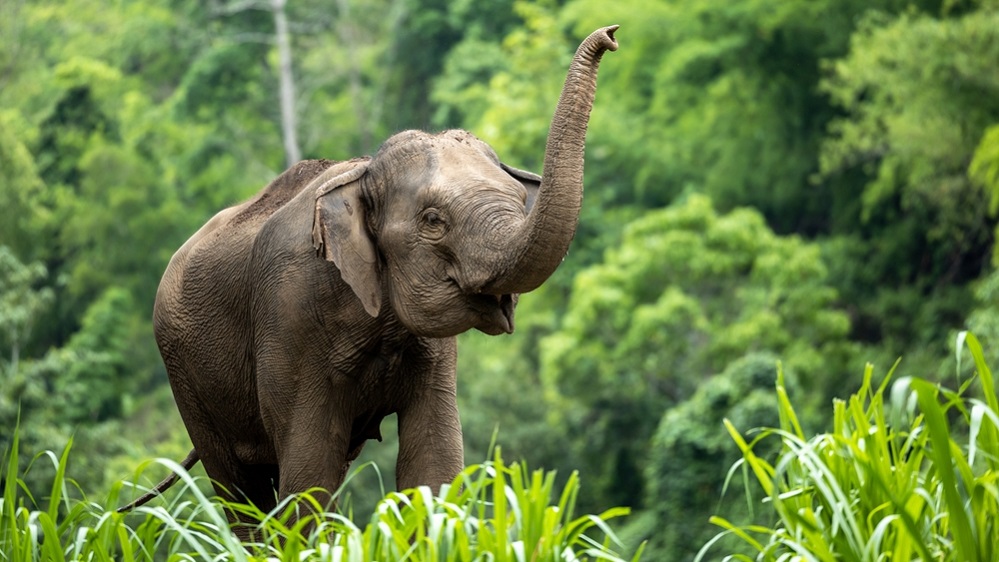Elephants, among the largest creatures, roam the heart of Africa’s vast savannahs and the lush forests of Asia. Their aura embodies strength, grace, and intelligence.
In this article, we embark on a journey into the fascinating realm of elephants, exploring their biology, appearance, types, behavior, conservation challenges, and cultural significance.

Appearance
Elephants are the largest existing land animals on the planet. Their appearance sets them apart from all other creatures on Earth. Here are some captivating features of these majestic giants:

Size
Elephants are renowned as the largest land mammals on Earth. These impressive creatures stand at a height of around 10 feet, reach about 18 to 24 feet long, and weigh anywhere from 4 to 8 tons. Their massive bodies are supported by thick, sturdy legs, and much of the skeletal structure is taken up by the huge skull, which supports the large ears, tusks, and trunk.
Trunk
The most unique feature of elephants is their elongated trunk, which actually originates from a fusion of the nose and upper lip. Comprising 40,000 individual muscle fibers without bones or cartilage and minimal fat, the trunk possesses remarkable flexibility. It can grasp objects as small as a seed and helps in crucial functions like breathing, drinking, feeding, and vocalizing.

Tusks
Tusks or “extended teeth” are another prominent feature of elephants. In African Elephants, both males and females typically grow tusks, whereas in Asian elephants, tusks are more commonly found in males.
Tusks provide various functions including protecting their trunks, lifting and moving objects, gathering food, self-defense, social interactions, and stripping bark from trees. Even during droughts, elephants utilize their tusks to dig holes and access water hidden underground.
Skin
Elephant skin is thick, wrinkled, and highly durable, providing protection against abrasions, insect bites, and the harsh rays of the sun. The texture of elephant skin is leathery, and the coloration varies among individuals and species, ranging from dark gray to reddish-brown.
Ears
Elephants have large, rounded ears with a unique feature, helping them to release excess body heat and regulate their body temperature. Flapping their ears is a common behavior, indicating either aggression or excitement. Elephants can hear the calls from another elephant as far as 2.5 miles away!
Scientific Classification

Facts About Elephants
Here are 12 interesting facts about Elephants:
- The largest recorded elephant measured 13 feet tall and weighed a massive 12 tons.
- Elephants typically consume approximately 25–50 gallons or 100–200 liters of water per day.

- There are 3 different species of elephants recognized by their ears: African Savanna, African Forest, and Asian.
- Elephants consume almost 150 kg of food daily.
- Elephants recognize themselves in a mirror.
- In most regions, an elephant’s skin measures about 2.5 cm thick.
- The elephant is one of the smartest animals worldwide.
- An elephant can carry weight up to 7 tons.
- Elephants can hear the calls from another elephant as far as 2.5 miles away.
- An elephant can run at a speed of up to 25 miles per hour.
- Elephants become sexually mature at the age of 10-14 years.
- Elephants have a gestation period of almost 22 months.
Types of Elephants
Elephants are typically categorized into the following three main types:
African Bush Elephant (Loxodonta Africana)

The largest among all elephant species, the African bush elephant primarily inhabits the savannahs and forests of sub-Saharan Africa. On average, an adult African bush elephant typically weighs between 4,500 and 6,800 kg. African bush elephants are characterized by their large ears, prominent tusks, and their distinctive wrinkled skin.
African Forest Elephant (Loxodonta Cyclotis)

They are typically smaller than the African Bush Elephants and are found in the dense rainforests of central and western Africa. On average, an adult African forest elephant generally weighs between 2,700 to 5,400 kg.
Asian Elephant (Elephas Maximus)

Asian Elephants are found in various habitats across Asia, including forests, grasslands, and scrublands. They are smaller in size compared to African elephants and have smaller ears, and typically only males have visible tusks. The weight of an adult Asian elephant generally ranges from 2,700-4,000 kg.
Habitat of Elephants

African Bush Elephants are found in the savannahs and woodlands of sub-Saharan Africa. Additionally, they can also be found in dense forests and semi-desert regions.
African Forest Elephants are found in the dense rainforests of central and western Africa. They are adapted to the wild challenges of the forest environment.
Asian Elephants can be found in a variety of ecosystems throughout Asia, encompassing tropical forests, grasslands, and scrublands. Countries include India, Sri Lanka, Thailand, Myanmar, and Indonesia. Their habitat comprises water sources and dense vegetation for feeding and bathing.
Diet of Elephant

Elephants are herbivores, meaning they primarily consume plants to sustain themselves. They require an enormous amount of food; an adult elephant can consume up to 150 kg of food in a single day. On average, elephants spend about 18 hours a day feeding.
Their diet typically consists of any type of vegetation like roots, grasses, fruit, and bark. Additionally, water is also an essential part of an elephant’s diet and hydration needs. Elephants require access to freshwater sources for drinking and bathing, and they may travel long distances in search of water during dry seasons.
Population of Elephants

According to the WWF, the global population of African elephants is approximately 400,000, while there are an estimated 40,000 to 50,000 Asian elephants remaining.
Since 1979, the habitat of African elephants has been reduced by over 50%, while Asian elephants retain only about 15% of their original range. The Asian elephant and African bush elephant are classified as “endangered,” whereas the African forest elephant is categorized as “critically endangered.”
Predators and Threats
While adult elephants are relatively safe from natural predators due to their size and strength, some small elephants are attacked by lions, hyenas, and leopards. Apart from natural predators, elephants face numerous threats:

Poaching: Poaching remains one of the most significant threats to elephant populations, due to the high value of their tusks.
Human-Elephant Conflict: As human populations expand, elephants are increasingly losing their habitats to agricultural and developmental activities. This not only endangers elephant populations but also poses risks to human safety, often resulting in retaliatory killings and strained relations between communities and elephants.
Habitat Loss and Fragmentation: Deforestation, agriculture, mining, and urbanization by human activities lead to the loss and fragmentation of elephant habitats. Elephants need a lot of room, so habitat destruction and fragmentation pose challenges for elephants in finding food, water, and maintaining social connections.
Climate Change: Extreme weather events, extended droughts, and changes in rainfall patterns can increase the difficulties encountered by elephants, affecting the availability of water, food, and suitable habitats.
Lifespan of Elephants

In their natural habitat, African elephants have an average lifespan of 60 to 70 years. Asian elephants have a slightly shorter lifespan compared to their African counterparts. They typically live for 50 to 60 years on average.
Oldest Elephant

Vatsala of Panna holds the distinction of being the oldest living elephant at 105 years old, surpassing Changalloor, which lived to the age of 89 years. Chengallor Dakhshayani, who passed away in 2019, held the title of the oldest captive elephant in Asia and was recognized by the Guinness World Records.
Interaction With Humans
Interactions between elephants and humans have been diverse and complex throughout history. Here are some positive and negative aspects:

Work and Transportation: Due to their remarkable strength, intelligence, and navigational abilities, elephants have been utilized in different tasks including logging, agriculture, and transportation.
Cultural and Religious Events: Elephants are recognized for their cultural importance across many societies and hold prominent positions in religious ceremonies.
Entertainment: In some regions, elephants are used for tourism and entertainment purposes, including elephant rides, performances, and elephant camps.
Zoo: Elephants in zoos represent a unique interaction of humans with elephants. Zoos provide educational opportunities for visitors to explore elephant behavior, biology, and conservation efforts. However, the limited space and unnatural social dynamics can lead to stress and health issues for these majestic creatures. Due to their food and space requirements, only select zoos have the resources to accommodate elephants.
Circus: Elephants in circuses have long been a subject of controversy, concerns persist regarding the ethical treatment and welfare of these animals. Training methods can be harsh and include punishment, causing stress and harm to the elephants. A rising movement seeks to end the use of elephants in circuses, with some regions implementing bans on their participation.
FAQs
How Many Species of Elephants Are There?
There are three species of elephants: African bush elephant, African forest elephant, and Asian elephant.
How Much Do Elephants Eat in a Day?
Elephants can consume up to 150 kg of food per day.
What Is the Lifespan of an Elephant?
In their natural habitat, elephants have an average lifespan of 50 to 70 years. In captivity, elephants typically live up to 40 years, although female Asian elephants in zoos have an average lifespan of only about 19 years, as reported by National Geographic.
What Is the Largest Elephant Ever Recorded?
The largest elephant ever recorded stood approximately 13 feet tall and weighed about 12 tons.
Which Is the Oldest Elephant Ever Recorded?
Vatsala of Panna holds the distinction of being the oldest living elephant at 105 years old, surpassing Changalloor, which lived to the age of 89 years.
Are Elephants Endangered?
Yes, all species of elephants are considered threatened or endangered.
Do Elephants Have Predators?
While adult elephants do not have many natural predators, young elephants may be preyed upon by lions, hyenas, and occasionally, leopards.
How Many Offspring Do Elephants Typically Have?
Elephants typically give birth to a single calf at a time.
How Many Stomachs Does an Elephant Have?
Elephants have only one stomach.
What is an Average Weight of Newborn Elephant
The average weight of a newborn elephant is around 200 to 250 pounds.
Final Words
The elephant, characterized by its majestic stature and gentle demeanor, stands as one of the most iconic creatures in the animal kingdom. It serves as a symbol of the remarkable diversity and beauty of life on Earth.
However, human beings have been their greatest threat. Yet, by working together with dedication, compassion, and empathy, we can create a world where elephants roam freely in their natural habitats, their legacy enduring for generations to come.














